Will I Owe Taxes if I Sell My Home?

If you plan to see your primary residence, will you have to pay taxes on your home sale?
What are capital gains and losses?
First, let’s review capital gains and how they relate to home selling. You probably know that you pay ordinary income tax when you earn money from a job or interest on a bank account. Additionally, when you sell certain assets and have a profit, you must pay capital gains tax.
You have a capital gain when you sell a capital asset, such as stocks, mutual funds, exchange-traded funds, or real estate, for more than it costs. The capital gains tax rate depends on your income, tax filing status, and the time you owned the asset.
Note that if you sell a capital asset for a loss, you have a capital loss, which can offset similar capital gains for a period, reducing the amount of tax you owe. However, if you sell a home for less than you paid, you can’t claim a capital loss or deduct it from your taxable income.
But you get a massive tax break when you profit from your home sale. So, if you’re like Al and thinking about selling your home, it’s critical to understand how it works and who qualifies for it.
What is the capital gains tax exclusion?
The tax break for homeowners is called the capital gains tax exclusion. It’s a federal benefit that allows you to exclude up to $250,000 of home sale gain from your income as a single taxpayer or $500,000 if you’re married and file a joint tax return.
Let’s say you’re married, file taxes jointly, bought your home for $300,000, and have lived there for 20 years. After several renovations over the decades, your adjusted basis is $500,000. You sell the property and realize $1.2 million on the sale, giving you a capital gain of $700,000 ($1.2 million – $500,000 = $700,000).
You can exclude $500,000, leaving you with a $200,000 ($700,000 – $500,000) capital gain. If you owned this same home as a single taxpayer, you’d be eligible to exclude $250,000, leaving you with a $450,000 ($700,000 – $250,000) capital gain.
Who qualifies for the capital gains tax exclusion?
However, to qualify for the exclusion, you must have owned and lived in the home for at least two years during the five years preceding the sale, and they don’t have to be contiguous. That rule is a primary reason I recommend waiting to buy a home until you’re confident you’ll live there for at least two years.
The home must be your primary residence to qualify for the capital gain tax exclusion. It can be any type of home, such as a single-family home, townhouse, condo, mobile home, tiny home, or houseboat. While you can own other properties, like vacation homes or rentals, they don’t qualify for this tax benefit.
And what’s really great is that you can claim the gains exclusion as often as you like, no matter your age or income. In theory, you could buy a home, live in it, and sell it every two years for your entire life to claim the exclusion over and over. While the thought of moving that often just for the exclusion exhausts me, it’s legal!
I want to mention that the IRS wasn’t always so generous. The gains exclusion used to apply only when you bought a more expensive home within two years of selling your old one. Plus, you could only claim the exclusion once in your lifetime for up to $125,0000 if you were 55 or older.
Al, I’m wondering if that old rule is why you asked if the price of your new home matters. Unfortunately, you will be taxed on your home sale profit, less the $250,000 exclusion if you’re single. I’ll explain how to figure out your tax in a moment.
If you’re married, only one spouse must be listed as the homeowner to qualify for the $500,000 exclusion. However, both must have lived in the home for at least two of the five years before the sale.
Note that if you’re a widow or widower who doesn’t remarry before selling your home within two years after your spouse’s death, you generally qualify to exclude up to $500,000 in gains, as if your spouse were still alive.
There are legal exceptions where you qualify for the full or partial gains exclusion even if you sell your home before living in it for two of the previous five years. They include:
Serving in the military or Foreign Service
Being a government official or employee of the intelligence community
Volunteering for the Peace Corps
Having your home destroyed or condemned
Getting separated or divorced
Experiencing the death of a spouse
You may also get a partial gain exclusion if you sell your home before living in it for two years due to a change in your health, workplace location, or having various unforeseeable events as described in IRS Publication 523, Selling Your Homeopens pdf file.
I haven’t mentioned all the situations when you’re eligible or ineligible for the exclusion, so speak with a certified public accountant (CPA) if you need guidance. With some planning, correctly timing your sale and qualifying for the gains exclusion could be one of the biggest tax breaks you ever get!
What is the capital gains tax on real estate?
So, how do you calculate your capital gain and potential tax on a home sale? As I mentioned, it’s the difference between what you paid for your property and how much you sold it for.
But calculating your gain on a home sale gets somewhat complicated because you may have made renovations or significant repairs, known as capital improvements while living in the property. Plus, you typically have expenses to account for when selling your home.
Here are four basic steps to determine your capital gain on a home sale:
Calculate your basis.
Your basis in a home is your total investment in the property. It includes the purchase price plus expenses related to the purchase, like closing costs. Your basis also includes capital improvements that increase your home’s value, like remodeling a kitchen, installing a new roof, or replacing windows. But it doesn’t include typical repairs and maintenance.
Your home’s basis can also be decreased by allowable depreciation and payments received for home insurance claims. That’s why keeping good records for significant home-related expenses and insurance payments is critical.
Determine your realized amount.
Your home’s selling price minus expenses related to the sale, such as a real estate commission, marketing fees, and certain closing costs, is your realized sale amount.
Subtract your basis from your realized amount.
For instance, if your home’s basis is $300,000 and your realized amount is $450,000, you have a $150,000 capital gain.
Determine your capital gains tax rate.
Your capital gains tax rate depends on your income, tax filing status, and how long you owned the property. For 2024, if you have owned your home for over a year, the long-term capital gains tax rate applies, which ranges from 0% to 20% and is more favorable than short-term rates.
That’s why it’s typically best to own assets, like investments and your home, for at least a year. Plus, you may owe capital gains tax at the state level if your state collects it. As mentioned, owning your home for at least two years makes you eligible for the capital gains tax exclusion.
You can check TaxFoundation.org for current capital gains tax rates. You can also refer to IRS Publication 523, Selling Your Homeopens pdf file, which has a worksheet to determine your home’s basis and any gain you can exclude.
If you can exclude all your home’s gain, you don’t even have to report it on your tax return because the entire transaction is tax-free!
What if you must pay capital gains on a home sale?
If you’re like Al and can’t exclude all the gain from your home sale, you must report the taxable portion on Form 1040, Schedule D, Capital Gains and Lossesopens pdf file, and Form 8949, Sales and Other Dispositions of Capital Assetsopens pdf file. As mentioned, if you sell properties that are not your main home for a profit, you must pay capital gains tax on all of it.
This article originally appeared on Quickanddirtytips.com and was syndicated by MediaFeed.org.
More from MediaFeed:
Seniors, Are You Ready for Independent Living? Ask Yourself These 14 Questions

If you’re not ready to sacrifice your independent lifestyle and don’t need medical assistance or extra support, you may not feel ready for senior living. However, if it’s becoming increasingly difficult to keep up with home maintenance, chores, and transportation to activities and social events, independent living may be appealing to you. Independent living communities cater to aging adults who don’t require assisted living or nursing home-level care but are interested in a relaxing, stress-free lifestyle.
A transition to independent living can provide the support you need to pursue passions, learn new skills, or spend quality time with friends and the people you love. If you’re not sure whether you’re ready for independent living, the following signs and questions can help you decide if it’s the right choice.
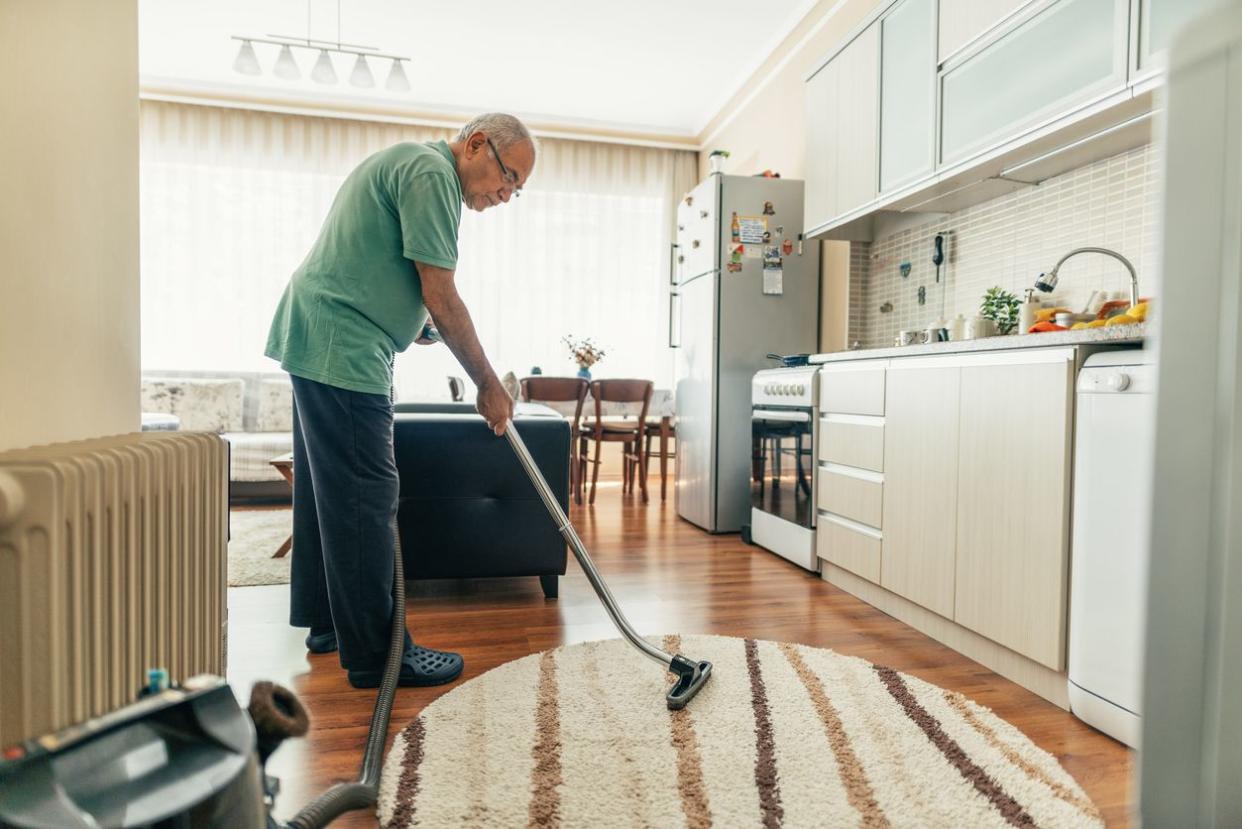
Maintaining a clean and safe home can be challenging for anyone, but it can become especially tiring as you age. Ask yourself the following questions to see if independent living is a match for your lifestyle:
Winxclub/ istock![<p>A good, reliable, and affordable cleaning service can be hard to come by. Independent living can eliminate this burden by offering convenient housekeeping services. Within A Place for Mom’s robust network of independent living communities, nearly 88% offer housekeeping, and approximately 75% offer laundry services.<sup>[01]</sup></p><span class="copyright"> AndreyPopov/istock </span>](https://s.yimg.com/ny/api/res/1.2/cFCqyoXtO9c5W8OHcVeL8Q--/YXBwaWQ9aGlnaGxhbmRlcjt3PTEyNDI7aD04Mjg-/https://media.zenfs.com/en/aol_mediafeed_842/27553430db90c49997faf284cad7f88a)
A good, reliable, and affordable cleaning service can be hard to come by. Independent living can eliminate this burden by offering convenient housekeeping services. Within A Place for Mom’s robust network of independent living communities, nearly 88% offer housekeeping, and approximately 75% offer laundry services.[01]
AndreyPopov/istock
After you’ve lived in your home for many years, maintenance issues, such as plumbing or electrical problems, tend to occur more frequently. Independent living offers on-site staff to make frantically searching for a handyman a thing of the past. The staff manage everything from hard-to-reach light bulbs to water leaks, all at no extra cost.
vicnt/ istock![<p>About 76% of Americans mow their lawn every two weeks, according to a recent survey.<sup>[02]</sup> Over 50 years of home ownership, this equates to 1,300 long afternoons of mowing. At independent living communities, the maintenance staff makes sure that lawns and paths remain well-groomed. Independent living residents can enjoy a cold beer on their lawn chair, without any of the work.</p><p><br></p><p class="server-jss144187 server-jss144211 server-jss144238 server-jss144572">If you enjoy particular parts of yard work, many independent living communities encourage you to exercise your green thumb. Many communities feature a community garden, enabling residents to volunteer at a local gardening club. A little over 60% of A Place for Mom’s independent living partners provide raised gardening beds, helping seniors with mobility issues to garden safely.<sup>[01]</sup></p><span class="copyright"> Depositphotos.com </span>](https://s.yimg.com/ny/api/res/1.2/jzWUlJGU2rVPeM.PiWeYRw--/YXBwaWQ9aGlnaGxhbmRlcjt3PTEyNDI7aD04Mjg-/https://media.zenfs.com/en/aol_mediafeed_842/3e4b46776cf8eaa75e089b8d85d0e228)
About 76% of Americans mow their lawn every two weeks, according to a recent survey.[02] Over 50 years of home ownership, this equates to 1,300 long afternoons of mowing. At independent living communities, the maintenance staff makes sure that lawns and paths remain well-groomed. Independent living residents can enjoy a cold beer on their lawn chair, without any of the work.
If you enjoy particular parts of yard work, many independent living communities encourage you to exercise your green thumb. Many communities feature a community garden, enabling residents to volunteer at a local gardening club. A little over 60% of A Place for Mom’s independent living partners provide raised gardening beds, helping seniors with mobility issues to garden safely.[01]
Depositphotos.com![<p>Senior isolation is common across the United States. As a matter of fact, almost a quarter of U.S. seniors live alone.<sup>[03]</sup> It’s normal for seniors to feel lonely sometimes — especially when children move away or a partner has passed.</p><p><br></p><p class="server-jss144187 server-jss144211 server-jss144238 server-jss144572">Use these questions to see whether loneliness is affecting you and how independent living may help:</p><span class="copyright"> monkeybusinessimages // istockphoto </span>](https://s.yimg.com/ny/api/res/1.2/FYw0B8nKGp8ZZlH97xS3DA--/YXBwaWQ9aGlnaGxhbmRlcjt3PTEyNDI7aD04Mjg-/https://media.zenfs.com/en/aol_mediafeed_842/1d9ce49a3a39deb9d71e0d3a53a9afd9)
Senior isolation is common across the United States. As a matter of fact, almost a quarter of U.S. seniors live alone.[03] It’s normal for seniors to feel lonely sometimes — especially when children move away or a partner has passed.
Use these questions to see whether loneliness is affecting you and how independent living may help:
monkeybusinessimages // istockphoto![<p>While living alone doesn’t inevitably lead to <a href="https://www.aplaceformom.com/caregiver-resources/articles/senior-isolation-facts" rel="nofollow noopener" target="_blank" data-ylk="slk:senior loneliness;elm:context_link;itc:0;sec:content-canvas" class="link rapid-noclick-resp">senior loneliness</a>, the two often go hand-in-hand. Isolation can negatively affect a senior’s mental health and well-being, and it may increase the risk of diseases and early mortality.<sup>[04]</sup>. Independent living communities offer daily social opportunities without the hassle of transportation or plans.</p><span class="copyright"> DepositPhotos.com </span>](https://s.yimg.com/ny/api/res/1.2/F51401DTJlcsYymrr_yzVw--/YXBwaWQ9aGlnaGxhbmRlcjt3PTEyNDI7aD04Mjk-/https://media.zenfs.com/en/aol_mediafeed_842/5d8b5b327f4aae3267f424c485a6f5f4)
While living alone doesn’t inevitably lead to senior loneliness, the two often go hand-in-hand. Isolation can negatively affect a senior’s mental health and well-being, and it may increase the risk of diseases and early mortality.[04]. Independent living communities offer daily social opportunities without the hassle of transportation or plans.
DepositPhotos.com![<p>Loneliness may not be the reason you want to socialize more. You may just want more opportunities to make friends or try new things. If so, independent living is ideal because it allows you to fill your calendar with fulfilling <a href="https://www.aplaceformom.com/caregiver-resources/articles/independent-living-activities" rel="nofollow noopener" target="_blank" data-ylk="slk:activities;elm:context_link;itc:0;sec:content-canvas" class="link rapid-noclick-resp">activities</a> like happy hours, trivia nights, poker, and dance nights with friends and peers.</p><p><br></p><p class="server-jss144187 server-jss144211 server-jss144238 server-jss144572">Nearly all independent living communities within A Place for Mom’s network offer on-site activities to engage residents.<sup>[01]</sup> However, you can also spend a quiet evening on the couch if you prefer alone time.</p><span class="copyright"> Drazen Zigic/ istock </span>](https://s.yimg.com/ny/api/res/1.2/Cvqv1ugwpd9Q2XMba7xn0g--/YXBwaWQ9aGlnaGxhbmRlcjt3PTEyNDI7aD04Mjg-/https://media.zenfs.com/en/aol_mediafeed_842/c9e07174c0e9ebfacda0cda608dbab00)
Loneliness may not be the reason you want to socialize more. You may just want more opportunities to make friends or try new things. If so, independent living is ideal because it allows you to fill your calendar with fulfilling activities like happy hours, trivia nights, poker, and dance nights with friends and peers.
Nearly all independent living communities within A Place for Mom’s network offer on-site activities to engage residents.[01] However, you can also spend a quiet evening on the couch if you prefer alone time.
Drazen Zigic/ istock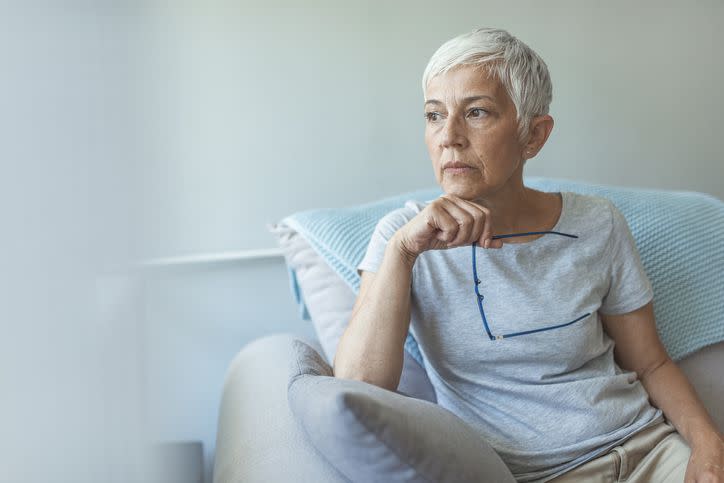
Over the years, you may find that the neighborhood around you has changed due to new neighbors or construction. Ask yourself the following to see if independent living may offer a better environment:
dragana991 / istockphoto![<p>The average home in the United States is around 2,300 square feet.<sup>[05]</sup> If you’re an empty-nester, all that space can feel lonely, and maintaining it can be time-consuming and expensive. Independent living offers multiple floor plans, from studio apartments to two-bedroom cottages, to help you downsize and feel more comfortable.</p><span class="copyright"> jacoblund/ istock </span>](https://s.yimg.com/ny/api/res/1.2/NB4M8M9sgGf3rweNYQWtWA--/YXBwaWQ9aGlnaGxhbmRlcjt3PTEyNDI7aD04Mjg-/https://media.zenfs.com/en/aol_mediafeed_842/1e6ca26be4989b674cbadf8907aa41bf)
The average home in the United States is around 2,300 square feet.[05] If you’re an empty-nester, all that space can feel lonely, and maintaining it can be time-consuming and expensive. Independent living offers multiple floor plans, from studio apartments to two-bedroom cottages, to help you downsize and feel more comfortable.
jacoblund/ istock
As you age, you may naturally crave more peace and quiet. This can become difficult if you live next to noisy children or neighbors who throw rowdy parties. Luckily, most independent living communities require residents to be 55 or older, allowing you to float in a splash-free pool, enjoy a quiet evening on your porch, or dine in an adults-only restaurant.
Liderina // istockphoto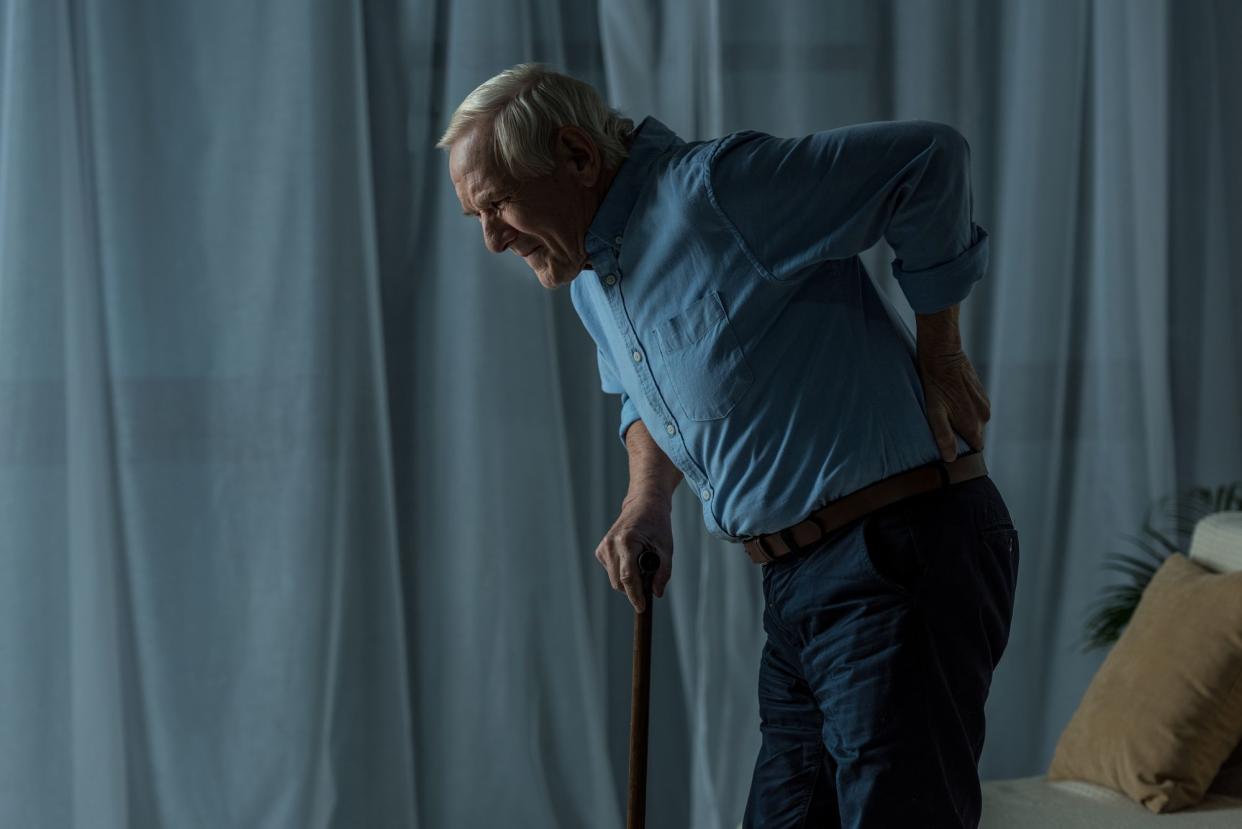
Living alone or becoming less mobile in a big house may make you fearful of trespassers. Of course, you can add security measures, but you may also be paranoid about forgetting to set your security system or checking your locks before bed.
Independent living eliminates this worry, because most communities have nightly security patrols, alarm systems, up-to-date locks, and other safety features. These added security protocols reduce the risk of theft and provide residents with much-needed peace of mind.
DepositPhotos.com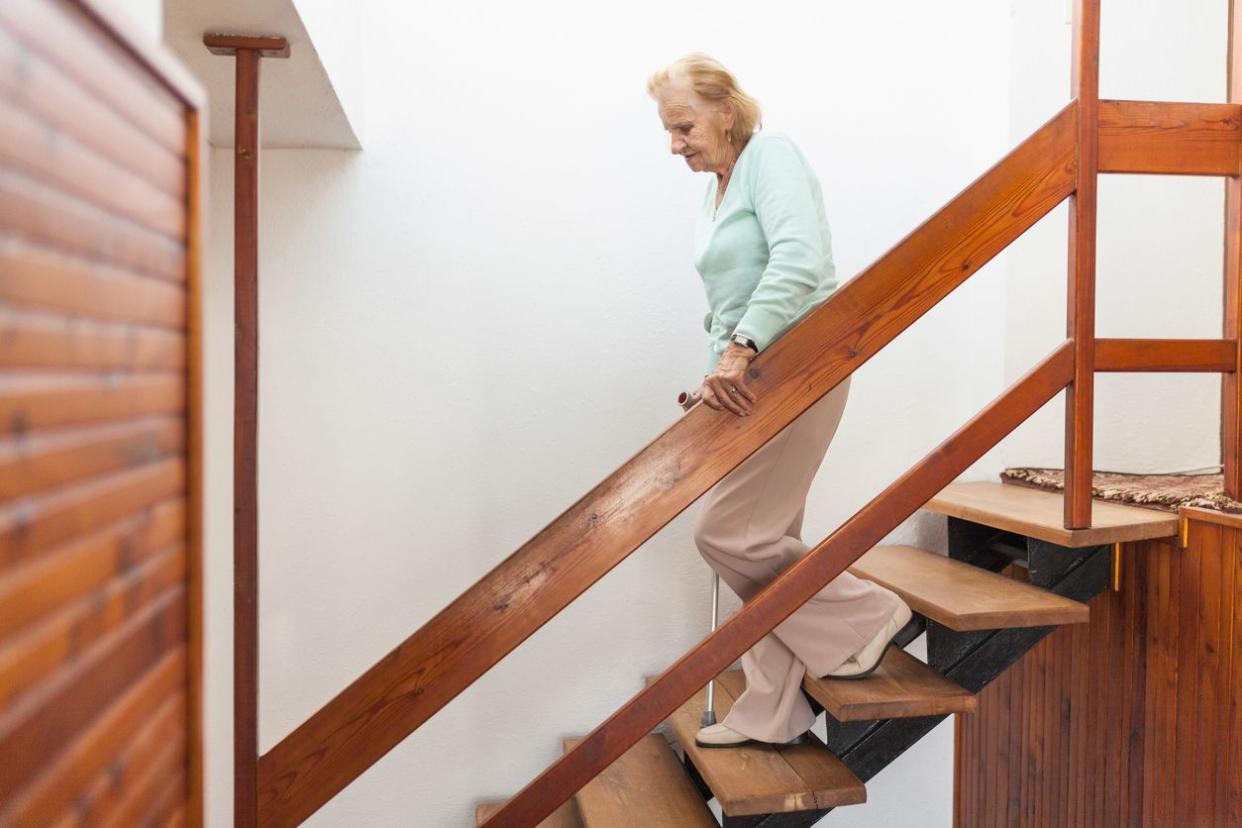
Aging often causes mobility issues that require safety modifications like stair lifts and grab bars in the home. If you’d rather not worry about these expenses and modifications, independent living communities are designed with senior’s safety and accessibility in mind. Most communities have low thresholds, widened doorways, and elevators for upper-level homes. Grab bars, fall alert systems, and walk-in tubs are other common features.
AND-ONE/ istock
As you reach retirement, you may want to pursue hobbies and interests that you didn’t have time for while working or raising a family. However, your current obligations may hinder your ability to pursue such interests.
Ask yourself these questions to see if independent living is the right fit for your interests:
DepositPhotos.com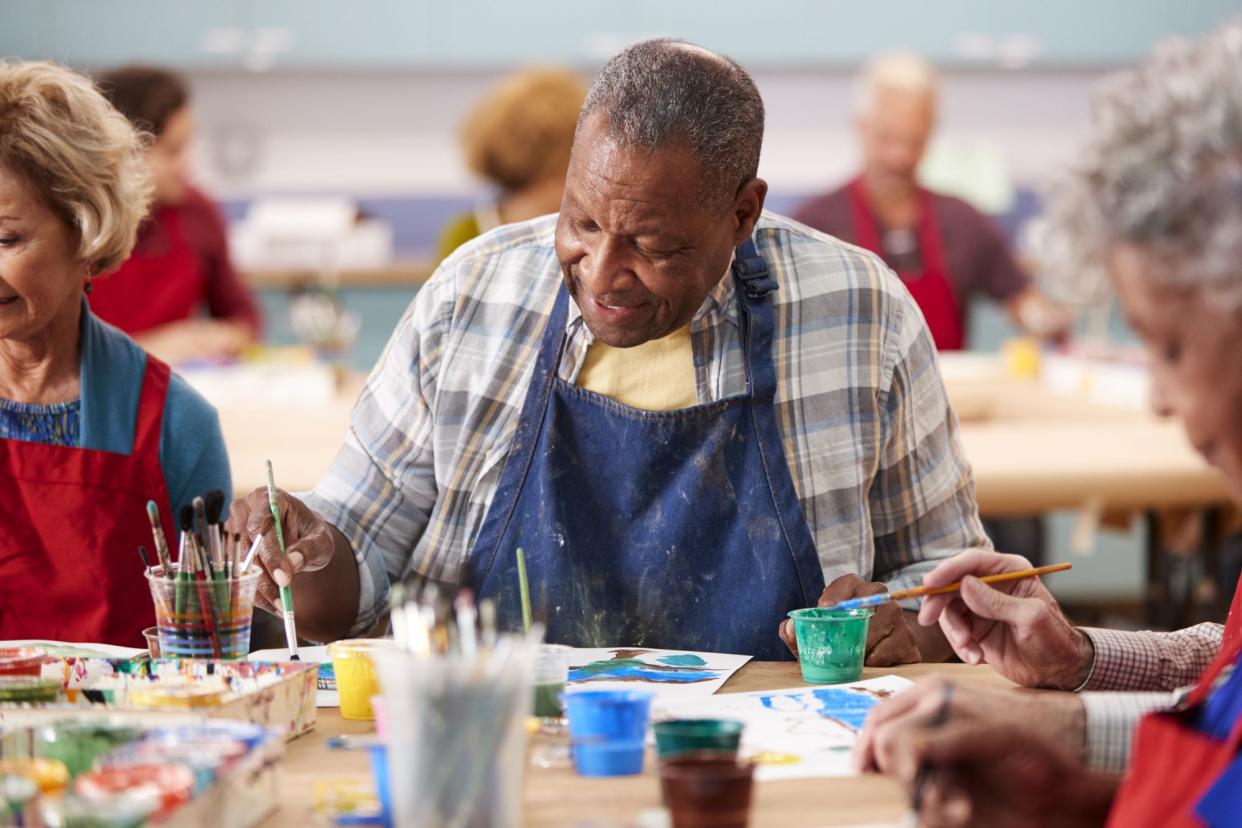
An independent living retirement grants you the opportunity to pursue interests you may not have had time for previously. Inclusive activities like painting, music, and gardening allow you to rediscover old passions or find new ones.
Depositphotos.com![<p>Continued learning increases psychological well-being and reduces the likelihood of <a href="https://www.aplaceformom.com/caregiver-resources/articles/everything-to-know-about-dementia" rel="nofollow noopener" target="_blank" data-ylk="slk:dementia in aging adults;elm:context_link;itc:0;sec:content-canvas" class="link rapid-noclick-resp">dementia in aging adults</a>.<sup>[08,09]</sup> To help seniors expand their skills and knowledge, independent living communities often host guest lectures from local professors, have weekly language lessons, or promote book clubs.</p><p><br></p><p class="server-jss144187 server-jss144211 server-jss144238 server-jss144572">Within A Place for Mom’s independent living network, approximately 77% of communities offer lifelong learning opportunities.<sup>[01]</sup> Flower arranging, computer literacy, and even mechanics are other common opportunities.</p><span class="copyright"> DepositPhotos.com </span>](https://s.yimg.com/ny/api/res/1.2/Zc2SH24KblnUYiQH28WfEQ--/YXBwaWQ9aGlnaGxhbmRlcjt3PTEyNDI7aD04Mjg-/https://media.zenfs.com/en/aol_mediafeed_842/fe89d8e8060e08f7fd744a6faf8039ba)
Continued learning increases psychological well-being and reduces the likelihood of dementia in aging adults.[08,09] To help seniors expand their skills and knowledge, independent living communities often host guest lectures from local professors, have weekly language lessons, or promote book clubs.
Within A Place for Mom’s independent living network, approximately 77% of communities offer lifelong learning opportunities.[01] Flower arranging, computer literacy, and even mechanics are other common opportunities.
DepositPhotos.com![<p>Regular exercise can help older adults stay independent, prevent health problems that come with age, and have a better quality of life.<sup>[06]</sup> It’s recommended for seniors to get 30 minutes of light physical activity at least five times a week.<sup>[07]</sup></p><p><sup><br></sup></p><p class="server-jss144187 server-jss144211 server-jss144238 server-jss144572">Getting enough exercise can be tough for seniors who aren’t motivated to join a gym or attend classes at a senior center. Independent living communities often offer on-site gyms and classes designed for older adults.</p><p class="server-jss144187 server-jss144211 server-jss144238 server-jss144572"><br></p><p class="server-jss144187 server-jss144211 server-jss144238 server-jss144572">In A Place for Mom’s network, nearly a third of independent living communities have on-site fitness centers, and about 85% of them offer exercise classes.<sup>[01]</sup> Options like water aerobics, yoga, and hiking clubs mean there’s usually something everyone will enjoy.</p><span class="copyright"> Sabrina Bracher/iStock </span>](https://s.yimg.com/ny/api/res/1.2/2TTLtOfQa4Fda46vgwt.oA--/YXBwaWQ9aGlnaGxhbmRlcjt3PTEyNDI7aD04Mjg-/https://media.zenfs.com/en/aol_mediafeed_842/c5078d8e1db3adef20183e9ca93bc609)
Regular exercise can help older adults stay independent, prevent health problems that come with age, and have a better quality of life.[06] It’s recommended for seniors to get 30 minutes of light physical activity at least five times a week.[07]
Getting enough exercise can be tough for seniors who aren’t motivated to join a gym or attend classes at a senior center. Independent living communities often offer on-site gyms and classes designed for older adults.
In A Place for Mom’s network, nearly a third of independent living communities have on-site fitness centers, and about 85% of them offer exercise classes.[01] Options like water aerobics, yoga, and hiking clubs mean there’s usually something everyone will enjoy.
Sabrina Bracher/iStock
Seniors often think they’re giving up some level of their independence when choosing independent living, but much like the name implies, these communities are built to help you maintain your independence. You can choose to do any level of cooking, cleaning, or driving as you’re able to.
Consider these questions about your level of independence and explore how independent living may assist you:
DepositPhotos.com![<p>Some seniors prefer not to drive, while others still very much enjoy it. Fortunately, independent living accommodates both. Seniors can bring their own cars with them or utilize on-site transportation services.</p><p><br></p><p class="server-jss144187 server-jss144211 server-jss144238 server-jss144572">Within A Place for Mom’s independent living network, over 95% of communities offer parking for residents, and about 90% offer complimentary or at-cost transportation services.<sup>[01]</sup> For communities that don’t offer transportation, the concierge is happy to coordinate rides using reliable, external services.</p><span class="copyright"> jacoblund / istockphoto </span>](https://s.yimg.com/ny/api/res/1.2/nciLPm20lrbIBdBP.nEcOA--/YXBwaWQ9aGlnaGxhbmRlcjt3PTEyNDI7aD04Mjk-/https://media.zenfs.com/en/aol_mediafeed_842/05d2ae20f8dae8e003fb5476e656aefd)
Some seniors prefer not to drive, while others still very much enjoy it. Fortunately, independent living accommodates both. Seniors can bring their own cars with them or utilize on-site transportation services.
Within A Place for Mom’s independent living network, over 95% of communities offer parking for residents, and about 90% offer complimentary or at-cost transportation services.[01] For communities that don’t offer transportation, the concierge is happy to coordinate rides using reliable, external services.
jacoblund / istockphoto![<p>You may not want to cook for each and every meal, but if you still want to cook <a href="https://www.aplaceformom.com/caregiver-resources/articles/easy-recipes-for-senior-nutrition" rel="nofollow noopener" target="_blank" data-ylk="slk:nutritious recipes;elm:context_link;itc:0;sec:content-canvas" class="link rapid-noclick-resp">nutritious recipes</a> on occasion, you certainly can. Within A Place for Mom’s network, approximately 85% of independent living communities offer a full kitchen or kitchenette within resident apartments.<sup>[01]</sup> More than half of the communities also offer cooking classes or a cooking club to help residents bond and cook together.</p><p><br></p><p class="server-jss144187 server-jss144211 server-jss144238 server-jss144572">Dining services are also available to seniors who don’t particularly enjoy cooking. Most communities offer at least two meals a day, if not three.</p><p class="server-jss144187 server-jss144211 server-jss144238 server-jss144572"><br></p><p class="server-jss144187 server-jss144211 server-jss144238 server-jss144572">About 80% of independent living communities offer restaurant-style dining and nearly 70% offer room service within A Place for Mom’s network.<sup>[01]</sup> Some even offer <a href="https://www.aplaceformom.com/caregiver-resources/articles/special-diets" rel="nofollow noopener" target="_blank" data-ylk="slk:special dietary accommodations;elm:context_link;itc:0;sec:content-canvas" class="link rapid-noclick-resp">special dietary accommodations</a> for gluten-free, vegetarian, and vegan diets.</p><span class="copyright"> Alessandro Biascioli/ istock </span>](https://s.yimg.com/ny/api/res/1.2/hHheVkV48zu5hpHwsCcEAg--/YXBwaWQ9aGlnaGxhbmRlcjt3PTEyNDI7aD04Mjg-/https://media.zenfs.com/en/aol_mediafeed_842/4beca45812ff6185170dc7f5daa1d44b)
You may not want to cook for each and every meal, but if you still want to cook nutritious recipes on occasion, you certainly can. Within A Place for Mom’s network, approximately 85% of independent living communities offer a full kitchen or kitchenette within resident apartments.[01] More than half of the communities also offer cooking classes or a cooking club to help residents bond and cook together.
Dining services are also available to seniors who don’t particularly enjoy cooking. Most communities offer at least two meals a day, if not three.
About 80% of independent living communities offer restaurant-style dining and nearly 70% offer room service within A Place for Mom’s network.[01] Some even offer special dietary accommodations for gluten-free, vegetarian, and vegan diets.
Alessandro Biascioli/ istock![<p>Seniors can leave the community at their leisure, host friends and family, and attend community-scheduled outings. However, there’s plenty of on-site entertainment, so residents don’t have to leave the premises for everything. For example, many communities offer movie theaters, pools, libraries, salons, and barbershops as on-site amenities.</p><p><br></p><p class="server-jss144187 server-jss144211 server-jss144238 server-jss144572">Furthermore, about 85% of independent living communities within our network schedule day trips and outings for residents.<sup>[01]</sup> A few outings could include an afternoon stroll in a park, a brunch at a local café, browsing museums, and so much more.</p><span class="copyright"> DepositPhotos.com </span>](https://s.yimg.com/ny/api/res/1.2/SBm0ESIQiS_WSG6L2_qqlg--/YXBwaWQ9aGlnaGxhbmRlcjt3PTEyNDI7aD04Mjc-/https://media.zenfs.com/en/aol_mediafeed_842/a6c0305b968dedaa0b3ca58543794b27)
Seniors can leave the community at their leisure, host friends and family, and attend community-scheduled outings. However, there’s plenty of on-site entertainment, so residents don’t have to leave the premises for everything. For example, many communities offer movie theaters, pools, libraries, salons, and barbershops as on-site amenities.
Furthermore, about 85% of independent living communities within our network schedule day trips and outings for residents.[01] A few outings could include an afternoon stroll in a park, a brunch at a local café, browsing museums, and so much more.
DepositPhotos.com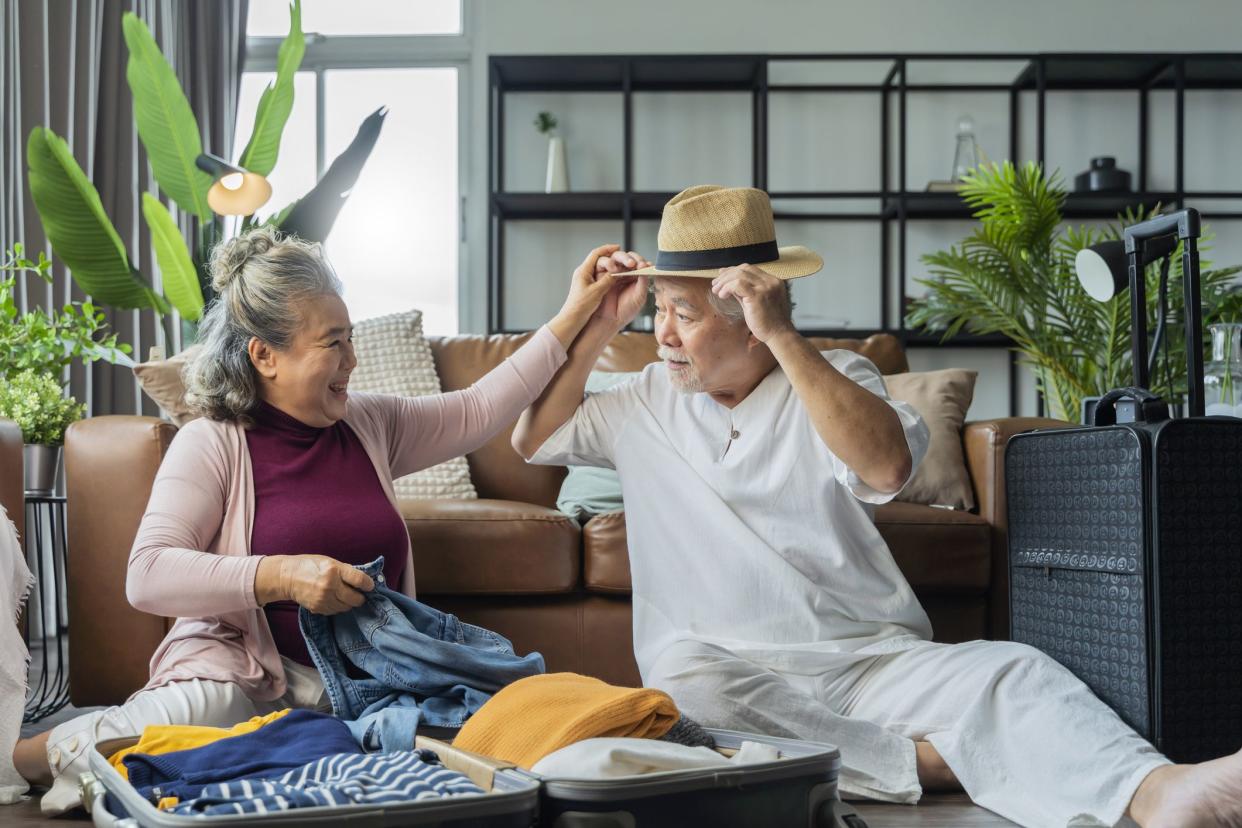
Independent living allows you to take trips as you please, but it offers further reassurance to residents. When you leave your independent living apartment, your home will be taken care of by the housekeeping and maintenance staff. This means there’s no need to ask for someone to watch your house, mow your lawn, or pick up your mail.
whyframestudio / iStock![<p>You don’t have to worry about having to give up a furry loved one while living in an independent living community, because you can bring your beloved pet with you. Over 90% of communities within A Place for Mom’s independent living network allow residents to bring their dogs and cats to live with them.[01]</p><span class="copyright"> DGLimages/ istock </span>](https://s.yimg.com/ny/api/res/1.2/pIc2U50jTdYHN50N_jHUgw--/YXBwaWQ9aGlnaGxhbmRlcjt3PTEyNDI7aD04Mjg-/https://media.zenfs.com/en/aol_mediafeed_842/634036c10c31818479eb209e25b7761f)
You don’t have to worry about having to give up a furry loved one while living in an independent living community, because you can bring your beloved pet with you. Over 90% of communities within A Place for Mom’s independent living network allow residents to bring their dogs and cats to live with them.[01]
DGLimages/ istock![<p>It’s common to worry about the future. You may think ahead to when independent living may not be able to meet your needs.</p><p><br></p><p class="server-jss144187 server-jss144211 server-jss144238 server-jss144572">If you’d rather not move to a new community again, you have options with <a href="https://www.aplaceformom.com/caregiver-resources/articles/ccrc" rel="nofollow noopener" target="_blank" data-ylk="slk:continuing care retirement communities (CCRCs);elm:context_link;itc:0;sec:content-canvas" class="link rapid-noclick-resp">continuing care retirement communities (CCRCs)</a> and senior living communities that offer multiple levels of care. These communities offer multiple levels of care on one campus — which may include independent living, <a href="https://www.aplaceformom.com/assisted-living" rel="nofollow noopener" target="_blank" data-ylk="slk:assisted living;elm:context_link;itc:0;sec:content-canvas" class="link rapid-noclick-resp">assisted living</a>, <a href="https://www.aplaceformom.com/alzheimers-care" rel="nofollow noopener" target="_blank" data-ylk="slk:memory care;elm:context_link;itc:0;sec:content-canvas" class="link rapid-noclick-resp">memory care</a>, and <a href="https://www.aplaceformom.com/caregiver-resources/articles/skilled-nursing-vs-nursing-homes" rel="nofollow noopener" target="_blank" data-ylk="slk:skilled nursing;elm:context_link;itc:0;sec:content-canvas" class="link rapid-noclick-resp">skilled nursing</a> — allowing seniors to move with minimal stress, because staff help residents move from one unit to another.</p><p class="server-jss144187 server-jss144211 server-jss144238 server-jss144572"><br></p><p class="server-jss144187 server-jss144211 server-jss144238 server-jss144572">Some independent living communities even coordinate with <a href="https://www.aplaceformom.com/home-care" rel="nofollow noopener" target="_blank" data-ylk="slk:home care agencies;elm:context_link;itc:0;sec:content-canvas" class="link rapid-noclick-resp">home care agencies</a> to help seniors receive the care they need without moving. For instance, over 60% of communities within A Place for Mom’s independent living network offer contracted care to help seniors age in place.<sup>[01]</sup></p><p class="server-jss144187 server-jss144211 server-jss144238 server-jss144572"><sup><br></sup></p><p class="server-jss144187 server-jss144211 server-jss144238 server-jss144572">If you decide you’re ready for independent living after assessing your needs, you may be unsure how to begin the process of <a href="https://www.aplaceformom.com/caregiver-resources/articles/how-to-choose-independent-living-facility" rel="nofollow noopener" target="_blank" data-ylk="slk:choosing an independent living community;elm:context_link;itc:0;sec:content-canvas" class="link rapid-noclick-resp">choosing an independent living community</a> to call home. A Place for Mom’s <a href="https://www.aplaceformom.com/eldercare-advisors" rel="nofollow noopener" target="_blank" data-ylk="slk:Senior Living Advisors;elm:context_link;itc:0;sec:content-canvas" class="link rapid-noclick-resp">Senior Living Advisors</a> can help you find options near you based on your budget, preferences, and needs. They can also help you compare options and answer questions you have, at no cost to your family.</p><p class="server-jss144187 server-jss144211 server-jss144238 server-jss144572"><br></p><p class="server-jss144187 server-jss144211 server-jss144238 server-jss144572"><i>This article originally appeared on <a href="https://www.aplaceformom.com/caregiver-resources/articles/ready-for-independent-living" rel="nofollow noopener" target="_blank" data-ylk="slk:A Place For Mom;elm:context_link;itc:0;sec:content-canvas" class="link rapid-noclick-resp">A Place For Mom</a> and was syndicated by <a href="https://mediafeed.org/" rel="nofollow noopener" target="_blank" data-ylk="slk:MediaFeed;elm:context_link;itc:0;sec:content-canvas" class="link rapid-noclick-resp">MediaFeed</a>.</i><br></p><span class="copyright"> DepositPhotos.com </span>](https://s.yimg.com/ny/api/res/1.2/1KMRr0f8YrvgjGIdjLrewA--/YXBwaWQ9aGlnaGxhbmRlcjt3PTEyNDI7aD05MTE-/https://media.zenfs.com/en/aol_mediafeed_842/24bc9f70678ba674f46bb3bc1ef0914a)
It’s common to worry about the future. You may think ahead to when independent living may not be able to meet your needs.
If you’d rather not move to a new community again, you have options with continuing care retirement communities (CCRCs) and senior living communities that offer multiple levels of care. These communities offer multiple levels of care on one campus — which may include independent living, assisted living, memory care, and skilled nursing — allowing seniors to move with minimal stress, because staff help residents move from one unit to another.
Some independent living communities even coordinate with home care agencies to help seniors receive the care they need without moving. For instance, over 60% of communities within A Place for Mom’s independent living network offer contracted care to help seniors age in place.[01]
If you decide you’re ready for independent living after assessing your needs, you may be unsure how to begin the process of choosing an independent living community to call home. A Place for Mom’s Senior Living Advisors can help you find options near you based on your budget, preferences, and needs. They can also help you compare options and answer questions you have, at no cost to your family.
This article originally appeared on A Place For Mom and was syndicated by MediaFeed.

